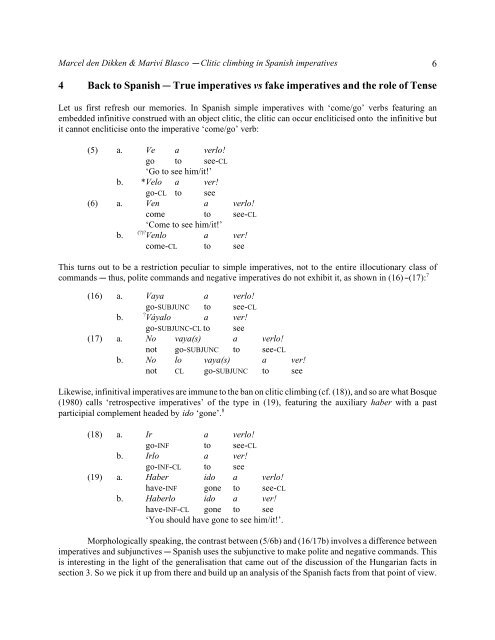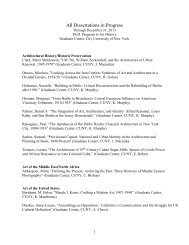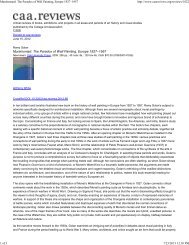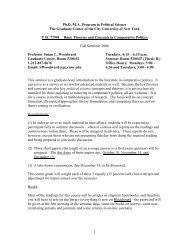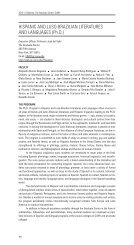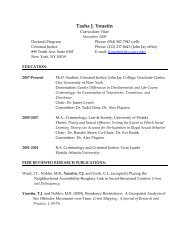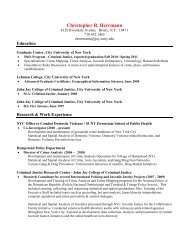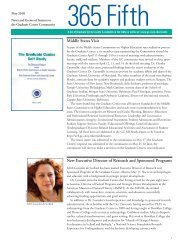Clitic climbing in Spanish imperatives - CUNY Graduate Center
Clitic climbing in Spanish imperatives - CUNY Graduate Center
Clitic climbing in Spanish imperatives - CUNY Graduate Center
Create successful ePaper yourself
Turn your PDF publications into a flip-book with our unique Google optimized e-Paper software.
Marcel den Dikken & Mariví Blasco & <strong>Clitic</strong> <strong>climb<strong>in</strong>g</strong> <strong>in</strong> <strong>Spanish</strong> <strong>imperatives</strong><br />
4 Back to <strong>Spanish</strong> & True <strong>imperatives</strong> vs fake <strong>imperatives</strong> and the role of Tense<br />
Let us first refresh our memories. In <strong>Spanish</strong> simple <strong>imperatives</strong> with ‘come/go’ verbs featur<strong>in</strong>g an<br />
embedded <strong>in</strong>f<strong>in</strong>itive construed with an object clitic, the clitic can occur encliticised onto the <strong>in</strong>f<strong>in</strong>itive but<br />
it cannot encliticise onto the imperative ‘come/go’ verb:<br />
(5) a. Ve a verlo!<br />
go to see-CL<br />
‘Go to see him/it!’<br />
b. *Velo a ver!<br />
go-CL to see<br />
(6) a. Ven a verlo!<br />
come to see-CL<br />
b.<br />
‘Come to see him/it!’<br />
(?)? Venlo a ver!<br />
come-CL to see<br />
This turns out to be a restriction peculiar to simple <strong>imperatives</strong>, not to the entire illocutionary class of<br />
commands & thus, polite commands and negative <strong>imperatives</strong> do not exhibit it, as shown <strong>in</strong> (16) %(17): 7<br />
(16) a. Vaya a verlo!<br />
go-SUBJUNC to see-CL<br />
b.<br />
?<br />
Váyalo a ver!<br />
go-SUBJUNC-CL to see<br />
(17) a. No vaya(s) a verlo!<br />
not go-SUBJUNC to see-CL<br />
b. No lo vaya(s) a ver!<br />
not CL go-SUBJUNC to see<br />
Likewise, <strong>in</strong>f<strong>in</strong>itival <strong>imperatives</strong> are immune to the ban on clitic <strong>climb<strong>in</strong>g</strong> (cf. (18)), and so are what Bosque<br />
(1980) calls ‘retrospective <strong>imperatives</strong>’ of the type <strong>in</strong> (19), featur<strong>in</strong>g the auxiliary haber with a past<br />
participial complement headed by ido ‘gone’. 8<br />
(18) a. Ir a verlo!<br />
go-INF to see-CL<br />
b. Irlo a ver!<br />
go-INF-CL to see<br />
(19) a. Haber ido a verlo!<br />
have-INF gone to see-CL<br />
b. Haberlo ido a ver!<br />
have-INF-CL gone to see<br />
‘You should have gone to see him/it!’.<br />
Morphologically speak<strong>in</strong>g, the contrast between (5/6b) and (16/17b) <strong>in</strong>volves a difference between<br />
<strong>imperatives</strong> and subjunctives & <strong>Spanish</strong> uses the subjunctive to make polite and negative commands. This<br />
is <strong>in</strong>terest<strong>in</strong>g <strong>in</strong> the light of the generalisation that came out of the discussion of the Hungarian facts <strong>in</strong><br />
section 3. So we pick it up from there and build up an analysis of the <strong>Spanish</strong> facts from that po<strong>in</strong>t of view.<br />
6


